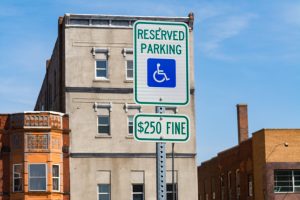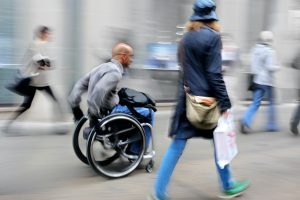By Helen Sullivan, APR, Fellow PRSA
“I am a quadriplegic in a wheelchair. Parking is the biggest obstacle in my life.”
READ AND RE-READ THIS QUOTE from the 2018 Accessible Parking Coalition (APC) National Survey and take in the full meaning of what this survey respondent shared with us. A quadriplegic is someone without the use of all four limbs. And the biggest obstacle in this person’s life is parking.
I hope this realization inspires you to tap into the resources of the IPMI-led Accessible Parking Coalition and develop a proactive plan to make accessible parking more accessible in your city, university, hospital, airport, corporate offices, shopping center, or stadium.
If you’re a consultant, are you counseling your clients to be mindful of access for all when planning a project? If you’re an equipment manufacturer, you may be surprised to learn that many meters are impossible to use for those with manual dexterity issues and the screen of many meters is angled such that even if payment can be made, a person in a wheelchair cannot view it.
There are so many challenges, and not everything that can be done is under your direct control, but there are many actions you can take to make a positive difference.
Getting Started
IPMI and its APC are making it easy for you get started. APC has just published a 24-page publication, “Let’s Make Accessible Parking More Accessible: A Practical Guide to Addressing Disabled Placard Abuse and Other Parking Issues for People with Disabilities.”
There is something of value in this new publication for parking lot and facilities designers, planners, managers, and operators. There are sections that will be illuminating for parking meter, pay station, and access control equipment manufacturers, as well as for those in parking enforcement, policy-making, community relations, and marketing.
Two of my favorite sections of this publication are where we share comments from people with disabilities—eye-opening!—and the section that summarizes a dozen action items you can take to make accessible parking more accessible. The publication has tons of real-world examples of what others in our industry are doing that works.
A strength of this new publication that should give you confidence in its ideas is the impressive list of reviewers: a stellar group of IPMI members on IPMI’s APC Advisory Council as well as the executive directors of the U.S. Access Board, the National Council of Independent Living, and Veterans of America, and, of course, APC spokesperson and citizen activist Chris Hinds, now a city council member in Denver, Colo., among others.
Download “Let’s Make Accessible Parking More Accessible: A Practical Guide to Addressing Disabled Placard Abuse and Other Parking Issues for People with Disabilities” at parking-mobility.org/APCguide or on the APC website at accessibleparkingcoalition.org, where you’ll find a host of other resources. Let’s work together to make parking more accessible.#
HELEN SULLIVAN, APR, Fellow PRSA, is IPMI’s communications counsel. She can be reached at sullivan@parking-mobility.org.
 The Barcelona at Beaverton apartment complex in Beaverton, Ore., offers residents a private parking lot behind the building. Several residents with disabilities recently approached the city asking for on-street spaces to be flagged as accessible and reserved for them by apartment number instead, saying the back lot is too far from their apartments, especially in inclement weather. And that’s created some controversy: City officials say reserving spaces on the street amounts to privatizing public spots, while disabled residents say the property’s parking lot spaces aren’t really accessible.
The Barcelona at Beaverton apartment complex in Beaverton, Ore., offers residents a private parking lot behind the building. Several residents with disabilities recently approached the city asking for on-street spaces to be flagged as accessible and reserved for them by apartment number instead, saying the back lot is too far from their apartments, especially in inclement weather. And that’s created some controversy: City officials say reserving spaces on the street amounts to privatizing public spots, while disabled residents say the property’s parking lot spaces aren’t really accessible.
 By Helen Sullivan, APR, Fellow PRSA
By Helen Sullivan, APR, Fellow PRSA